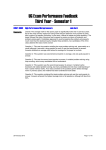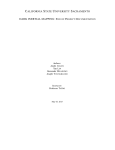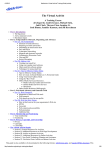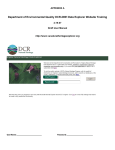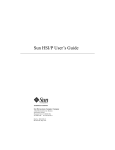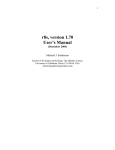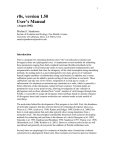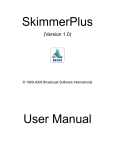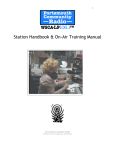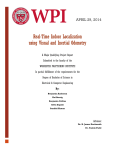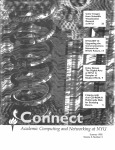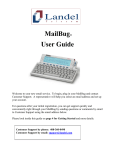Download Virtual Activist
Transcript
Using the Internet For Outreach and Organizing A Virtual Activist Training Reader ______________________________________________________________________ <NetAction>> 601 Van Ness Ave. #631 San Francisco, CA 94102 Phone: (415) 775-8674 Fax: (415) 673-3813 Email: [email protected] Web: http://www.netaction.org NetAction is a project of The Tides Center, a 501(c)(3) organization. 1 Table of Contents Traditional versus Internet Communications 2 Getting Started With Email Activism 3 Is Your Action Alert Ready to Circulate in Cyberspace? 4 What Makes This An Effective Action Alert? 5 What’s Wrong With This Action Alert? 7 Is it outreach, or is it spam? 9 Tips for Effective Online Media 11 How to Create A “Bcc” Email List 13 Cyber Security Checklist 19 Online Resources for Email Activism Online Media Advocacy Resources __ _ 21 23 Online Resources for Cyber Security__________________25 About NetAction: NetAction is a San Francisco-based non-profit organization dedicated to teaching activists how to use the Internet for organizing, outreach, and advocacy, and to educating the public and policy makers about technology policy. For more information, please contact us. Copyright 1996-2002 by NetAction/The Tides Center. All rights reserved. Material may be reproduced for non-commercial use provided NetAction is cited. NetAction 601 Van Ness Ave, Suite #631 San Francisco, CA 94102 Phone: (415) 775-8674 Email: [email protected] URL: http://www.netaction.org/ 2 Traditional Versus Internet Communication1 Communication Method Traditional Techniques Internet Techniques Press release distribution Mail, fax Email, web pages, electronic wire services Press contacts Newspapers, TV, radio, wire services Online media (e.g. CNet, Salon) Newsletters Print Email, web pages Rallies Hold rallies Virtual online town halls House parties Hold house parties Chat rooms Visits to legislators Conduct visits Web comment forms Tabling Conduct tabling Web sign-up sheets Phone trees Phoning Pass along email ("Pass on to 5 Friends" emails) Letters to legislators Mail, fax Online fax servers Letters to non-legislative policymakers Mail, fax Email Letters to the editor Mail, fax Email Op-Ed pieces Mail, fax Email Faxes Traditional fax machine Online faxing Postcards Mail Electronic images emailed online Petitions Paper Web pages Action alerts Printed notices on bulletin boards, mail, fax, phone tree Email, web pages Organizing around a specific interest Support groups, neighborhood groups News groups 1 This chart was created for an Email Activism Workshop sponsored by the California Abortion and Reproductive Rights Action League (CARAL) and is used with permission. NetAction 601 Van Ness Ave, Suite #631 San Francisco, CA 94102 Phone: (415) 775-8674 Email: [email protected] URL: http://www.netaction.org/ 3 Getting Started With Email Activism Virtually all of the written materials that your organization produces can be adapted for electronic distribution via email, the Web, or both. Here are some tips to help you get started: Start with a clear understanding of what you want to accomplish and who you want to reach. Is your constituency online?2 If not, are you trying to expand your base of support? Make sure you have the resources to maintain an online presence, and determine who will be responsible for answering email. Once you create a web site or launch an email newsletter or discussion list, who will manage it? Collect email addresses from your members, supporters and volunteers, the media, your contacts in legislative offices, your funders and anyone else you communicate with regularly. Include a space for email addresses in your membership sign-up forms, newsletter subscription forms, and fundraising reply cards. If your organization publishes a newsletter, offer your members the option of receiving it electronically, and encourage them to switch by reminding them that your organization will save money. If your organization has a Web site where visitors can sign up to volunteer, to subscribe to a newsletter or action alert, or to donate money, be sure to ask for an email address as well as other contact information. If your organization has a table at a conference, rally, or other event, include space for an email address on your sign-up sheet. If you distribute press releases to the media, start sending them by email instead of fax. (Also, be sure to add online media outlets to your distribution list.) Use email to communicate with staff consultants in legislative offices. Establish and promote an email action alert list. 2 See the Pew Internet Project at: http://www.pewinternet.org/reports/index.asp for reports on the demographics of Internet users. NetAction 601 Van Ness Ave, Suite #631 San Francisco, CA 94102 Phone: (415) 775-8674 Email: [email protected] URL: http://www.netaction.org/ 4 Is Your Action Alert Ready to Circulate in Cyberspace? A NetAction Checklist Will readers know who sent the action alert? Clearly identify your organization as the source of the action alert. Will readers know how to contact your organization? Include complete contact information: email address, postal address, web site address, phone number and fax number. Whenever possible, include the name, title, and phone number of the person to contact with questions. Will readers know if the action alert is timely? Always include the date that your action alert is distributed and the date by which action is requested. (And don’t forget to include the year!) Will readers be compelled to read the action alert? Communicate a sense of urgency with a provocative or compelling subject line, so readers will open the alert and take action. Never leave the subject line blank. Will readers understand why action is important? Include clear, concise background information, pointers to Web sites with more information and the key points to communicate. Avoid jargon and keep the format simple with short paragraphs, section headings, and horizontal lines. Don’t assume the reader is familiar with the issue. Will readers know what action to take? Be specific about what you want the reader to do. Include the postal address, fax number or phone number if you are asking readers to write letters, send faxes or make phone calls. Include a pointer to online information to help readers locate their elected representatives. Are you sure of the facts? Electronic action alerts can literally go around the world in minutes. Since you won’t know exactly who sees your alert, factual errors aren’t easily corrected. Verify facts by checking with a trusted organization or individual before you hit the “send” key. Are you building your base of support? Always include information on how readers can join your organization, volunteer to help, subscribe to (or unsubscribe from) the action alert list. Visit the Virtual Activist at http://www.netaction.org/training for more tips. NetAction 601 Van Ness Ave, Suite #631 San Francisco, CA 94102 Phone: (415) 775-8674 Email: [email protected] URL: http://www.netaction.org/ Dedicated email address 5 What Makes This An Effective Action Alert? From: [email protected] To: Cc: Bcc: Hidden email addresses [email protected]; [email protected]; [email protected]; [email protected]; [email protected]; [email protected]; [email protected]; [email protected]; [email protected]; [email protected]; [email protected]; [email protected]; [email protected]; [email protected]; [email protected]; [email protected]; [email protected]; [email protected]; [email protected]; [email protected]; [email protected]; [email protected]; [email protected]; [email protected]; [email protected]; [email protected]; [email protected]; [email protected]; [email protected]; [email protected]; [email protected]; [email protected]; [email protected]; [email protected]; [email protected]; [email protected]; [email protected]; [email protected]; [email protected] Subject line identifies alert Subject: ACTION ALERT: Call Your Supervisor to Protect IHSS Benefits Clear directions for action * * * * * * * * * Do not circulate this alert after Wednesday, March 6, 2002 * * * * * * * * * * Action Alert: Call your supervisor to protect IHSS benefits from eligibility cutbacks Expiration date The San Francisco Board of Supervisors is scheduled to vote Thursday, March 7, 2002, on a proposal to decrease the maximum allowable income that qualifies an individual or a couple for free In Home Supportive Services. A DECREASE IN THE MAXIMUM ALLOWABLE INCOME COULD MEAN THAT YOU WILL HAVE TO MAKE A CO-PAYMENT IN ORDER TO RECEIVE THESE SERVICES. Even if your income is just $1 over the maximum allowable income, you could be required to pay several hundred dollars per month for services that you now receive for free! Call your Supervisor today and urge him or her to vote “No” on the proposed eligibility change. Forward this message to your friends and neighbors who have email. Print copies and distribute them to those who don’t. ----------------------------------------------------------------------------------------------------------------------------Phone numbers for the Board of Supervisors: Supervisor Tom Ammiano, president Chris Daly Matt Gonzalez Tony Hall Mark Leno Phone No. 554-5144 554-7970 554-7630 554-6516 554-7734 Supervisor Sophie Maxwell Jake McGoldrick Gavin Newsom Aaron Peskin Gerardo Sandoval Leland Yee Phone No. 554-7670 554-7410 554-5942 554-7450 554-6975 554-7752 Contact numbers included NOTE: Call the Elections Department – 554-4375 – if you don’t know which Supervisor’s district you are in. If you tell them your street address, they can tell you which Supervisor represents your district. --------------------------------------------------------------------------------------------------------------------------------NetAction 601 Van Ness Ave, Suite #631 San Francisco, CA 94102 Phone: (415) 775-8674 Email: [email protected] URL: http://www.netaction.org/ Talking points included 6 What to say to your supervisor when you call: * Any decrease in the maximum allowable income for IHSS will be a hardship for San Francisco seniors and persons with disabilities. * An individual who earns just $1 per month over the current maximum is already required to pay more than $200 per month for services that are free to individuals earning just $1 less per month. * Decreasing the maximum allowable income will force people who are spending hundreds of dollars per month on co-payments to spend even more on IHSS. That means they will have less to spend on food, rent, and other necessities. * There are other programs that the City can reduce that won’t create hardships for the elderly and persons with disabilities. Supervisors should cut “optional” programs – such as subsidies to professional sporting events -- instead of IHSS. --------------------------------------------------------------------------------------------------------------------------------- Brief background Background IHSS regulations provide a way for individuals or married couples to be eligible for assistance with personal care and/or housekeeping tasks if their income is more than SSI allows but still considered low-income. These services make it possible for them to remain safely in their own homes. Pointer to info on web Detailed information on eligibility, and contact information for the program, is on the web at: http://www.seniorsurvivalschool.org/survival_sheets/share.htm ------------------------------------------------------------------------------------------------------------------------------Contact information: Contact info includes email and web Any Group Text broken into 1370 Main Street, 3rd Floor sections separated San Francisco, CA 94108 by breaks Phone: 415-555-0000 Email: [email protected] Web: http://www.anygroup.org -----------------------------------------------------------------------------------------------------------------------------Subscription information: To subscribe: send email to [email protected] with the word “subscription” in the subject line. Leave the message window blank. To unsubscribe: send email to [email protected] with the word “unsubscribe in the subject line. Leave the message window blank. Subscription information included NetAction 601 Van Ness Ave, Suite #631 San Francisco, CA 94102 Phone: (415) 775-8674 Email: [email protected] URL: http://www.netaction.org/ A better address would7be: [email protected] What Wrong With This Action Alert?` From: [email protected] To: [email protected]; [email protected]; [email protected]; [email protected]; [email protected]; [email protected]; [email protected]; [email protected]; [email protected]; [email protected]; [email protected]; [email protected]; [email protected]; [email protected]; [email protected]; [email protected]; [email protected]; [email protected]; [email protected]; [email protected]; [email protected]; [email protected]; [email protected]; [email protected]; [email protected]; [email protected]; [email protected]; [email protected]; [email protected]; [email protected]; [email protected]; [email protected]; [email protected]; [email protected]; [email protected]; [email protected]; [email protected]; [email protected]; [email protected] Addresses belong in the “Bcc” field To: Bcc: Subject: Doesn’t state that action is needed Paratransit service threatened Action Alert: Paratransit service threatened! No expiration date for the alert Contract talks between MUNI and Intellitran have broken down. MUNI officials have taken a hard line in negotiations and informed Intellitran that they will not extend the current contract past the deadline if a new agreement isn’t reached. The current contract will expire at 11:59 p.m. Friday. This means that no paratransit service will be available after 12 a.m. Saturday if a new contract agreement isn’t reached! Contact the Mayor’s office TODAY and urge Mayor Brown to order MUNI to continue services under the current contract until the negotiations are concluded. ***************************************************************** Background on the issue The Americans with Disabilities Act (ADA) paratransit service is a publicly funded program of the City and County of San Francisco to provide alternative transportation for qualified disabled persons unable to use MUNI’s fixed route transportation. This is a specialized service provided by MUNI for persons with disabilities who qualify under ADA. MUNI contracts with Intellitran to administer the service as Paratransit Broker. Transportation under the program is provided by seven participating taxi companies (Luxor, Desoto, Yellow Cab, Town Taxi, National, Serra Cab, Daly City Cab, and Pacific Cab). Group van service is also available for social and health service agencies. Lift-equipped vans and ramp-equipped taxis are also available. This program provides a vital service to qualified persons with disabilities. Transportation to appointments with physicians, therapists, social service agencies and grocery stores will be not be available if service is disrupted until negotiations are concluded. ***************************************************************** What you can do to help Put this above background 1) Call Mayor Brown’s office today: 415-123-4567 NetAction 601 Van Ness Ave, Suite #631 San Francisco, CA 94102 Phone: (415) 775-8674 Email: [email protected] URL: http://www.netaction.org/ 8 The Mayor has authority to order MUNI to extend the current contract while negotiations continue. Urge Mayor Brown to intervene to ensure that paratransit service continues without interruption. A sample script would be helpful 2) Spread the word to other concerned citizens If your friends and neighbors have email, forward this message. If not, you can still spread the word by printing copies of this alert to give to friends and neighbors, or by calling them. ************************* Any Group 1370 Main Street, 3rd Floor San Francisco, CA 94106 Phone: 415-555-0000 NetAction 601 Van Ness Ave, Suite #631 San Francisco, CA 94102 Missing email & web contact info Phone: (415) 775-8674 Email: [email protected] URL: http://www.netaction.org/ 9 Is It Outreach, or Is It Spam? NetAction’s Tips for Virtual Activists In the hands of an experienced organizer or activist, email can be a powerful tool for outreach. Even inexperienced users of the Internet can make effective use of email for outreach and organizing on a global scale. A simple keystroke or a single click of the mouse, and you reach thousands of people, almost instantaneously. But is it outreach, or is it spam? As more activists go online, more complaints about unsolicited email, or spam, are sure to arise. Here are some tips that should help you avoid being “flamed” with angry replies. First, some tips on making your email outreach effective: Keep the text short and focused. It may be tempting to provide a detailed analysis, but if your goal is to motivate people to action, get right to the point. Write a subject line that's compelling or provocative. Keep in mind that the subject line is the first thing the recipient will see. The more compelling you make it, the more likely it is that the message is going to be read. Identify yourself. Remember to include all your contact information: phone, address, fax, email, URL if you have a Web site. Everyone is faceless in cyberspace. You'll have far more credibility -- and will probably get better results -- if you clearly identify yourself, your organization, and your cause. Include contact information for decision-makers. You’ll get better results if you include the telephone, fax, and postal address of the decision-makers you are asking people to contact. If your organization has a Web site with a fax server, include the URL for the fax server; most email software recognizes URLs and enables the reader to click directly onto the site. Compile and maintain a list of the newsgroups and email lists you post to. Once you’ve identified the best places to post your alerts, keep the addresses on hand for future use. If your email allows you to set up individual mailboxes, create one for these addresses so you can send them in a single message. (Use the “Bcc” field if mailing to multiple addresses. Break up the text in long email alerts with ascii-friendly symbols. If your alert is more than two or three paragraphs, use symbols such as these * ~ ^ = + to break up the text by creating lines or boxes. NetAction 601 Van Ness Ave, Suite #631 San Francisco, CA 94102 Phone: (415) 775-8674 Email: [email protected] URL: http://www.netaction.org/ 10 Send a test message before sending out alerts. Always send a copy of the alert to yourself or to a colleague before distributing it. Check the format to make sure there are no broken lines or other problems. Check any URLs that you include in the alert to make sure they work properly. Now, some things to avoid: Don't send out unsolicited mass emailings. We know it's tempting! But if you want to communicate about an issue with a large number of people, only send your message to email discussion lists and/or news groups that focus on the issues the alert addresses. Don't subscribe people to email lists without their permission. If you want to create your own email distribution list, start by sending a message to appropriate discussion lists and news groups, announcing the new list and inviting people to subscribe. Be as specific as possible about the topic and how the list will operate. Will it be an unmoderated discussion list, or a moderated announcement list? Will there be several postings daily, or one posting every few weeks? Don't put email addresses in the “To" or "Cc" field when sending alerts. Put your own email address in the "To" field and use the "Bcc" field for all the others. That way, the people who receive your message won't get the email addresses of everyone else who receives the message. And you avoid the risk that one of the recipients of your message will capture the email addresses of all the other recipients and either subscribe them to a list without their permission, or include them in an unsolicited mass emailing. Don’t send action alerts asking people to contact decision-makers by email. Most decision-makers don’t read email, and even those who do read it don’t give it as much weight as a letter, fax, or phone call. Don’t use wide margins in email messages. Wide margins in email messages don’t always wrap automatically, which causes breaks in the lines of text when it arrives in the recipient’s email In Box. Don’t post alerts to discussion lists or news groups on unrelated issues. If the topic of your action alert is clean air, you’ll just annoy people if you send it to a discussion list focused on free speech. The topic of the discussion list or news group should be related to the issue you address in your message. Don’t leave the subject line blank! This is a sure way to annoy people. NetAction 601 Van Ness Ave, Suite #631 San Francisco, CA 94102 Phone: (415) 775-8674 Email: [email protected] URL: http://www.netaction.org/ 11 Tips for Effective Online Media Email is an excellent tool for communicating with media. It is a cost-effective way to quickly distribute press releases and newsletters, and is also useful for submitting letters to the editor or opinion articles. Electronic press releases and newsletters can also be posted to your Web site. NetAction offers the following suggestions for communicating online. Tips for Effective Online Media: Distribute email press releases in plain ascii text. Draft your press release as you would any other email message, using an email software program such as Eudora or Microsoft Outlook. Never send press releases as attachments to email, or attach other documents to email press releases. If you need to prepare a paper copy of the press release, copy and paste the ascii text into a word processing document (such as Microsoft Word) after the release is written in the email browser. Keep the text brief and focused. An electronic press release should follow the same “pyramid” format as any other press release. Start with the most important information (and remember the five “W’s” − who, what, where, when and why). Use short paragraphs and keep it brief. Write a subject line that's compelling or provocative. Keep in mind that the subject line is the first thing reporters and editors will see when they download your release. Never email a press release (or any other message) with a blank subject line. Include your electronic contact information. Remember to include your email address and Web site URL in addition to your phone and fax number, and address. Put all your contact information at the top of the press release. Use hyper-links where appropriate. If there is additional information available on your Web site − such as a white paper or an event announcement − include a hyper-link so reporters can click right to it. Online publications will often include these links in their stories, making this an effective way to direct visitors to your Web site. Send a test message before distributing your press release. Always send a copy of the press release to yourself or to a colleague before distributing it. Check the format to make sure there are no broken lines of text, and check for any mis-typed Web URLs by testing them to make sure they work. NetAction 601 Van Ness Ave, Suite #631 San Francisco, CA 94102 Phone: (415) 775-8674 Email: [email protected] URL: http://www.netaction.org/ 12 Avoid disclosing the recipients’ email addresses. Always type the recipients’ addresses in the “Bcc” field of your email message header, rather than in the “To” or “Cc” field. (See NetAction’s “How to Create A ‘Bcc’ Email Media List.”) Post your organization’s media contact information on the home page of your Web site. Be sure to keep the contact information up-to-date, and include information on how reporters can be added to your mailing list. Treat email media inquiries the same as phone inquiries. Always respond just as promptly to email media inquiries as you would to phone calls. Reporters who work for online publications are much more likely to contact you by email than by phone. If you’re responsible for answering media inquiries, check your email frequently throughout the day. Set up an online archive for your media communications. Set aside an area of your Web site where reporters can locate past press releases. (If you publish a newsletter in electronic form, maintain an online archive of past issues, as well.) Post press releases only to appropriate lists, news groups, and publications. If you plan to post your press release to any email discussion lists, news groups or online publications, make sure the topic of your release is appropriate content for the list or Web site. If your press release announces a new report on air pollution, it would not be appropriate content for a forum for race car enthusiasts, for example. Collect email addresses from your media contacts. If you’ve been distributing your press releases by fax or postal mail, ask your media contacts if you can switch to email distribution. Commercial media directors (such as Bacon’s Metro California Media) routinely include email contact information. Major newspapers frequently have separate staffs for their online versions, so you’ll need to include those contacts on your list, too. There are also media directories and news services specifically for online publications that may be appropriate to add to your media list. Limit the size of your email message window. In many email browsers, text that is longer than the width of the message window will “wrap” to the next line. (When text is set to “wrap,” you don’t need to hit the “return” key at the end of every line.) If the size of your message window is set for more than about 75, the automatic “wrap” may result in broken lines of text. NetAction 601 Van Ness Ave, Suite #631 San Francisco, CA 94102 Phone: (415) 775-8674 Email: [email protected] URL: http://www.netaction.org/ 13 How to Create A “Bcc” Email List The simplest way to create an email list for Internet activism is to use your regular email software. The most common products you might use are Qualcomm's Eudora, Microsoft Outlook, or Netscape Mail.3 To create your own email activism list, you will need to be familiar with two features of your email software: the address book and the “Bcc” field. Using Your Email Address Book Most email software programs have a feature that lets you set up an address book where you can store the email addresses of friends, relatives, and business associates. Most email address books will let you store hundreds or even thousands of names, making it a useful tool for creating a simple announcement-only email list that you can use to send out action alerts, press releases or email newsletters. For example, if your organization occasionally sends out press releases, you can set up an address book entry labeled "Media" to store the email addresses of reporters and editors so you won’t have to send individual messages to each of them. In the example below, we created a distribution list labeled “Alert List Sample” in Outlook. 3 Most Internet viruses and worms are created to target the widely used Outlook and Outlook Express. NetAction recommends Eudora (http://www.eudora.com) as a better alternative. NetAction 601 Van Ness Ave, Suite #631 San Francisco, CA 94102 Phone: (415) 775-8674 Email: [email protected] URL: http://www.netaction.org/ 14 Using the “Bcc” Field When the email addresses have been entered in the address book, your list is ready to use. But you’ll want to send messages to the list without disclosing any of the recipients' addresses. So if you haven't already been introduced to the "Bcc" field, it's time to get acquainted. When you open a “New Message” window in your email software, the message form will usually include a header that looks something like this: To: From: Subject: Cc: Bcc: X-Attachments ______________________________________________________ (Note: In some email software, "Bcc" is not included in the default setting of the header display. If you don't see it, try looking for a “Preferences” or “Options” menu, or check the "Help" file or the User Manual that came with the software, or contact the software company's support service by phone or email.) Using the “Alert List Example” in the previous illustration, here is how you can send a message without revealing the recipients’ email addresses: Type "Alert List Example" in the "Bcc" field of the message header (instead of in the “To” field) and type your own email address in the "To" field. When the message is sent, it will appear to have been sent from and received by you, and will look something like this: To: [email protected] From: [email protected] Subject: Action Alert: Paratransit service threatened Cc: Bcc: X-Attachments ______________________________________________________ Always use the "Bcc" field if you send email to a list you’ve created in your address book! Using the example above, if you had typed “Alert List Sample” in the "To" or "Cc" field, all of the recipients’ addresses would have been displayed when they opened the message. There are two problems with this. First, some people prefer not to disclose their email address. Also, if the address list is long, the header will be long. This is annoying to some people because they have to scroll through screens full of addresses before they see the message. If your list contains several hundred addresses, just imagine how annoying it will be to scroll through all those screens! Here is an example of an email message from someone who neglected to use the “Bcc” field: NetAction 601 Van Ness Ave, Suite #631 San Francisco, CA 94102 Phone: (415) 775-8674 Email: [email protected] URL: http://www.netaction.org/ 15 From: "Jane Doe" [email protected] To: James King <[email protected]>, Alan Williams <[email protected]>, Dave Garrison <[email protected]>, “Jennifer Reilly” <[email protected]>, "George Kelly" <[email protected]>, “Thomas Jones” <[email protected]>, Gina Rogers <[email protected]>, Dan Stevens <[email protected]>, Vincent Davis <[email protected]>, Ron Butler <[email protected], "Marc Smith" <[email protected]>, Tony Altura <[email protected], "Jeffrey Carr" <[email protected]>, “Michael Milton” <[email protected], Peter Boyd<[email protected]>, “Susan Smith” [email protected] _____________________________________________________________ In the illustrations that follow, we show the steps involved in setting up a distribution list in Outlook, and then generating a “Bcc” email message. Step 1: Click to open the address book. In the “Select Names” window, click “New.” In the “New Entry” window, click “New Distribution List.” NetAction 601 Van Ness Ave, Suite #631 San Francisco, CA 94102 Phone: (415) 775-8674 Email: [email protected] URL: http://www.netaction.org/ 16 Step 2: In the Distribution List window, type in a name for the list. In the “Add New Member” list, type in a new name and email address to add contacts that are not already in your contact list. NetAction 601 Van Ness Ave, Suite #631 San Francisco, CA 94102 Phone: (415) 775-8674 Email: [email protected] URL: http://www.netaction.org/ 17 Step 3: To add names that are already in your contact list, click “Select Members,” highlight the name you want to add, and click “Members.” NetAction 601 Van Ness Ave, Suite #631 San Francisco, CA 94102 Phone: (415) 775-8674 Email: [email protected] URL: http://www.netaction.org/ 18 Step 4: To send a message to the distribution list, click on the “Address Book,” select the distribution list from the “Select Names” window, and click the “Bcc” button. Use your own address in the “To” field of the message. NetAction 601 Van Ness Ave, Suite #631 San Francisco, CA 94102 Phone: (415) 775-8674 Email: [email protected] URL: http://www.netaction.org/ 19 NetAction’s Cyber Security Checklist Use this checklist of computer security basics to assess and improve your computer security practices: Do Your Work Habits Promote Security? Passwords and user names are your first line of defense in cyber security. Use passwords that are difficult to guess and change them frequently. (If you think you might forget your password, write it down and file it where only you can get to it.) Always remember to logoff when you aren’t using your computer. The most basic, and low-tech, security practice is to lock or shut down a computer when it’s not in use. If you don’t, there’s little point in password-protecting your hard drive. Can Your Data Be Restored If Your Computer Crashes? Regular backups are a crucial component of computer security. Documents and other data should be backed up daily. Backed up data can be stored on removable media (such as CDs), on a separate hard drive that is connected to your computer externally, on a tape drive, or on a secure web site. Redundancy is the best strategy: create several backup sets so at least one is stored off site. It’s also a good idea to periodically make a full backup of your hard drive so that if your hard drive crashes you won’t have to reinstall each software program individually. Many new computers include CD drives that make data backups easy and affordable. External hard drives that can be disconnected and stored off site are an affordable option for backing up a complete hard drive. Is Your Computer Safe From Viruses and Worms? New computer viruses and worms are discovered all the time. Installing and regularly updating your anti-virus software is essential to maintaining the security of your computer files. Is Your Computer Safe From Malicious Hackers? Every computer connected to the Internet without a firewall is vulnerable, but the risk is greater if you are using DSL or cable broadband, or are connected to an office network. Because these types of connections are typically always on, malicious hackers can get into your computer and steal confidential information, deface your organization's web site, or use your computer as part of a distributed denial of service (DDoS) attack directed at another server. Firewall software is available from many of the same developers who produce anti-virus software, including Symantec and McAffee. NetAction 601 Van Ness Ave, Suite #631 San Francisco, CA 94102 Phone: (415) 775-8674 Email: [email protected] URL: http://www.netaction.org/ 20 Are Your Mailing Lists Safe From Spammers? Email lists are frequent targets of spam, so mailing list security is a high priority. If you are running commercial list software, such as Majordomo, configure your email lists so only the list owner has access to subscribers’ addresses. If you are using your email client software, such as Eudora or Outlook, avoid disclosing subscribers' addresses by putting all your recipients’ addresses in the "Bcc" field. If you are using an application service provider, such as Topica or Yahoo Groups, make sure the lists are configured to prevent the disclosure of addresses. Also, back up your subscriber list regularly. Those addresses are one of your organization’s most important assets! Are Your Confidential Files Safe From Snoopers? Nearly everyone stores some data on their computer that is sensitive or confidential. Use passwords and encryption to protect private data. Disable operating system features that allow files to be shared unless it’s absolutely necessary, and when you do allow sharing use passwords to ensure that only authorized users have access. If you send or receive confidential data, encrypt your email messages. Do You Check “Under the Hood” Periodically? Although not strictly a security issue, good disk maintenance is also important. Several software vendors sell utility tools (such as Norton System Works) that can alert you to and fix minor problems, and sometimes even retrieve lost data. Specific maintenance requirements vary, so review the User Guide and check your disk periodically to ensure optimal performance. Are You Prepared for the Worst? Hard drives crash; accidents happen, natural disasters occur without warning. If you depend on computers, disaster planning is a necessity. Start by keeping an up-to-date backup of your hard drive off site, but don’t stop there. Inventory your hardware, software and service providers. Ask yourself what it would take to get back online if your office was destroyed in an earthquake or fire. Write it all down and keep a copy with your off site backup. Periodically review your plan to make sure it’s up-to-date. NetAction 601 Van Ness Ave, Suite #631 San Francisco, CA 94102 Phone: (415) 775-8674 Email: [email protected] URL: http://www.netaction.org/ 21 Online Resources for Email Activism Guides to Using Technology for Organizing NetAction's Virtual Activist Training Guide http://www.netaction.org/training/ A step-by-step guide to using the Internet as an activist tool. Organizers’ Collaborative http://www.organizenow.net/ Technology resources for grassroots organizations One/Northwest’s Activist Tool Kit http://www.onenw.org/ Comprehensive information and “how to” guides on Internet activism. The eNonprofit: A Guide to ASPs, Internet Services and Online Software http://www.compasspoint.org/enonprofit Tech Soup http://www.techsoup.org/ General resources for nonprofits using technology. Benton Foundation Best Practices http://www.benton.org/Practice/ List of resources to help nonprofit organizations use technology effectively. Designing Effective Action Alerts for the Internet http://dlis.gseis.ucla.edu/people/pagre/alerts.html UCLA professor Phil Agre provides advice on how to design an effective online action alert. Against Chain-Letter Petitions on the Internet http://dlis.gseis.ucla.edu/people/pagre/petitions.html Professor Agre discusses the problems with chain email petitions. Online Political and Legislative Resources Project Vote Smart http://www.vote-smart.org/ Comprehensive information on federal, state and local candidates and elected officials. California Voter Foundation http://www.calvoter.org Bipartisan online electoral information and voter guides. NetAction 601 Van Ness Ave, Suite #631 San Francisco, CA 94102 Phone: (415) 775-8674 Email: [email protected] URL: http://www.netaction.org/ 22 Thomas http://thomas.loc.gov/ U.S. Congress web site with links to legislation and representatives’ offices. Directories Google Groups locates news groups http://groups.google.com/ Publicly accessible mailing lists http://paml.net/ Bay Area Progressive Directory & Events Calendar http://www.emf.net/~cheetham/index.html Craigslist announcement mailing lists for Bay Area events, jobs, etc. http://www.craigslist.org/ Newstrawler searches for news on the Internet http://www.newstrawler.com/nt/nt_home.html NetAction 601 Van Ness Ave, Suite #631 San Francisco, CA 94102 Phone: (415) 775-8674 Email: [email protected] URL: http://www.netaction.org/ 23 Online Media Advocacy Resources Media Advocacy Guides and Tool Kits Managing the Media, A Guide for Activists http://tenant.net/Organize/media.html “Raising Our Voices,” A Tool Kit for Activists http://www.media-alliance.org/voices/index.html ConsumerNet's "How To Work With the Press" Guide http://www.consumernet.org/library/pr_writing.shtml ConsumerNet's "Nonprofit Publicity" Guide http://www.consumernet.org/library/publicity.shtml NetAction Notes 20 on Media Activism http://www.netaction.org/notes/notes20.html NetAction Notes 47 on Media Activism http://www.netaction.org/notes/notes47.html Online Media and News Services Institute for Global Communications http://www.igc.org Links to hundreds of progressive organizations. Media Alliance Links to Media Organizations http://www.media-alliance.org/medialinks.html Thousands of General Media Links http://ajr.newslink.org Ascribe Public Interest News Wire http://www.ascribe.org/ Working Assets Long Distance Alerts and News http://www.workingforchange.com/activism/index.cfm Links for Progressives and Media Activists http://www.nlightning.com/bookmarks.html Salon Magazine http://www.salon.com/ NetAction 601 Van Ness Ave, Suite #631 San Francisco, CA 94102 Phone: (415) 775-8674 Email: [email protected] URL: http://www.netaction.org/ 24 AlterNet http://www.alternet.org/ Common Dreams Newswire http://www.commondreams.org/community.htm One World Network http://www.oneworld.net/us/ NewsBytes News Service http://www.newsbytes.com NetAction 601 Van Ness Ave, Suite #631 San Francisco, CA 94102 Phone: (415) 775-8674 Email: [email protected] URL: http://www.netaction.org/ 25 Online Resources for Cyber Security The CERT Coordination Center has comprehensive information on all aspects of computer security: http://www.cert.org Stay Safe Online features more consumer-oriented security information: http://www.staysafeonline.info/index.adp Counterpane Internet Security has more technically-oriented information: http://www.counterpane.com/ NetAction Notes No. 76 on Cyber Security: http://www.netaction.org/notes/notes76.html Background information on firewalls is available at: http://www.interhack.net/pubs/fwfaq/ Additional information on DDoS attacks is available at: http://www.cert.org/archive/pdf/DoS_trends.pdf Symantic and McAffee have virus alert warnings on their websites: http://securityresponse.symantec.com/avcenter/ http://www.mcafee.com/anti-virus/ For detailed information on how to configure email lists, see: http://www.netaction.org/training/part2b.html For detailed information on using encryption software, see: http://www.netaction.org/encrypt/ Subscribe to NetAction Notes for monthly reports on Internet activism. http://www.netaction.org/notes NetAction 601 Van Ness Ave, Suite #631 San Francisco, CA 94102 Phone: (415) 775-8674 Email: [email protected] URL: http://www.netaction.org/



























